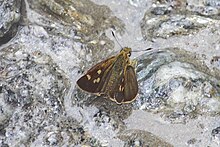Pedesta pandita
| Brown bush bob Pedesta pandita | |
|---|---|

| |
| Lateral view | |

| |
| Dorsal view | |
| Scientific classification | |
| Domain: | Eukaryota |
| Kingdom: | Animalia |
| Phylum: | Arthropoda |
| Class: | Insecta |
| Order: | Lepidoptera |
| Family: | Hesperiidae |
| Genus: | Pedesta |
| Species: | P. pandita |
| Binomial name | |
| Pedesta pandita (de Nicéville, 1885) | |
| Synonyms | |
| |
Pedesta pandita, the brown bush bob, is a species of skipper, a butterfly belonging to the family Hesperiidae. The species was first described by Lionel de Nicéville in 1885.[1]
Description
The wingspan of the brown bush bob is 25–30 mm (1.0–1.2 in).[1]
In 1891, in his Hesperiidae Indica, Edward Yerbury Watson wrote:
Upperside brown, sparsely clothed with ochreous scales. Forewing with a quadrate transverse spot at the end of the cell, three conjoined subapical ones, and two similar discal ones, semi-diaphanous ochreous. Cilia ochreous. Hindwing immaculate. Underside brown, forewing with the apex widely, and the costa and the entire hindwing ferruginous ochreous. Forewing with the spots as above.
Hindwing with a very indistinct small black spot at the end of the cell, and a discal series of similar short streaks between the nervules. Cilia ochreous.
Antennae black, the tip of the club and the upper portion of the shaft below the club ferruginous.[2]
Distribution and habitat
The brown bush bob is distributed from Sikkim to Arunachal Pradesh in India and is also found in Myanmar.[1] The flight of this infrequently seen species is fast and determined but not that fast as other fast-flying skippers. They usually fly close to the ground, and after a quick flight, will settle down in a preferred spot. They are usually spotted in wet soil or damp rock and are also found extracting nutrients from a bird droppings. Occasionally they will bask in the sun, opening their wings half-closed like other skippers. They are predominantly found in the lower elevation forest tracks or sometimes can be spotted near streams or falls.[1]
Seasonality
The brown bush bob is best seen from April to October.[1]
